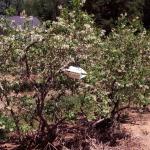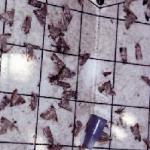Blueberry IPM - Cranberry & Cherry Fruitworm
Blueberry - Cranberry Fruitworm (Acrobasis vaccinii) & Cherry Fruitworm (Grapholita packardi)
ID/Life Cycle: Both Cranberry Fruitworm (CBFW) and Cherry Fruitworm (CFW) are native to North America, as are the blueberries they infest. The adult forms of these fruitworms are small brownish-gray or grayish-black moths. Eggs are small (1mm), oval in shape, and are pale creamy color. The eggs are laid near the calyx of green fruit. The larvae hatch as fruit begins to turn color and are found within blueberry fruit in June. The larvae are small (growing to 3/8 inch in length) and pale yellowish green (CBFW), or pale pinkish (CFW) in color, with darker head capsules.
Both CFBFW and CFW overwinter as larvae and pupate in the spring, emerging as adult moths after the start of bloom and usually before early fruit set. Once mated, moths move into blueberry plantings when fruit is small and green to lay eggs directly on the calyx end of the fruit. The larvae then tunnel into the fruit and begin feeding. Infested fruit turn prematurely blue making them easy to identify when scouting. The larvae will consume from 3 to 6 berries, filling them with brown frass (sawdust-like excrement), and web together fruit with silk. Upon reaching maturity, larvae leave the berries and move to over-wintering sites in nearby woods or hedgerows. There is one generation per year.
Damage: Larvae feed on ripening fruit. Feeding reduces crop yield and spoils marketability of the berries.
Management
Monitoring: Pheromone traps can be used to monitor male populations and to identify the initial flight into a blueberry planting. See Pest Management Supplies list here for sources of lures. Lures are available for both species. Traps should be placed during bloom with a minimum 50’ buffer between them. Place traps in an open area in the interior of the bush and mark with a bright flagging tape to make them easier to find upon return. Monitor trap catches twice weekly and remove moths caught each time you check. This, in order to identify when sustained captures occur and later when peak trap captures occur. Record trap captures at each visit for later reference. The onset of egg-laying roughly corresponds with 7-10 days after peak trap captures are recorded. Spray program should be focused on the egg laying period with two sprays at often needed during this time



Developmental Model: Fruitworm development is closely related to weather conditions for both species and can be predicted with reasonable accuracy using Degree Day accumulations. Cherry Fruitworm is thought to emerge at approximately 230 GDD Base 50˚F from March 1. Cranberry Fruitworm emerges later, around 350 GDD Base 50˚F. Emergence can be confirmed by using pheromone traps that capture male moths of each species. Noting the start of sustained trap captures can be used as the biofix (= the onset of sustained adult activity or flight) for the developmental model. Sustained capture is when moths are found in 2 successive trap checks.
The important stage to forecast for either species is egg-laying which, for CBFW, occurs during the period of 85-400 GDD Base 50˚F after biofix. Therefore, CBFW egg-laying is generally predicted to take place during the period of 435-750 GDD Base 50˚F from March 1 (i.e., 350GDD + 85-400GDD). Exact modeling for CFW egg-laying is not currently available but is likely somewhat earlier than CBFW.
Additional scouting can be done for egg laying by inspecting green fruit with a hand lens. Scout the periphery of the planting especially near woods and hedgerows. Finally, scout for infested fruit by looking for prematurely pigmented berries. These are usually easy to spot as they turn blue well before ripening is expected.
Control strategies
Cultural/Biological:
- Eliminate weeds and trash around plants to cut down on overwintering protection for larvae.
- Clean cultivate between rows to disrupt pupation sites and reduce the population of this pest.
- Hand pick and destroy infested fruit in small plantings.
- Preserve natural enemies whenever possible by selecting spray materials that are less toxic to beneficials.
Chemical:
- See New England Small Fruit Management Guide for currently recommended spray materials for Cherry or Cranberry Fruitworm.
- Apply recommended insecticides beginning 85 – 100 GDD base 50˚F after sustained trap catches (biofix), which usually coincide with berry-touch or when degree-day models reach the action threshold.
- Rotate insecticides from different IRAC groups to reduce the chance of resistance development in the pest.
- Avoid use of insecticides with seasonal use restrictions that may be needed for Spotted Wing Drosophila (SWD) control later in the season.
- Use pesticides that are less toxic to predators (e.g., insect growth regulators or B.t. products) to promote populations of natural enemies.
Date: February 2020
Author(s): Sonia Schloemann and Jaime Piñero, UMass Extension
Visit our website: http://ag.umass.edu/fruit
Note: This information is for educational purposes only and is reviewed regularly for accuracy. References to commercial products or trade names are for the reader’s information. No endorsement is implied, nor is discrimination intended against similar products. For pesticide products please consult product labels for rates, application instructions and safety precautions. The label is the law. Users of these products assume all associated risks.
This work was supported in part by funding provided by USDA NIFA Extension Implementation Program, Award No. 2017-70006-27137